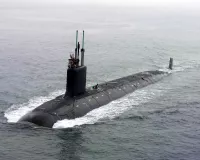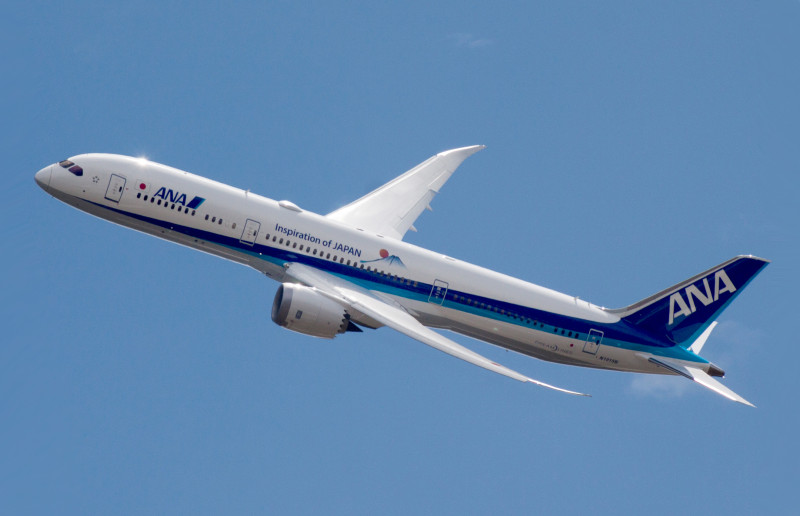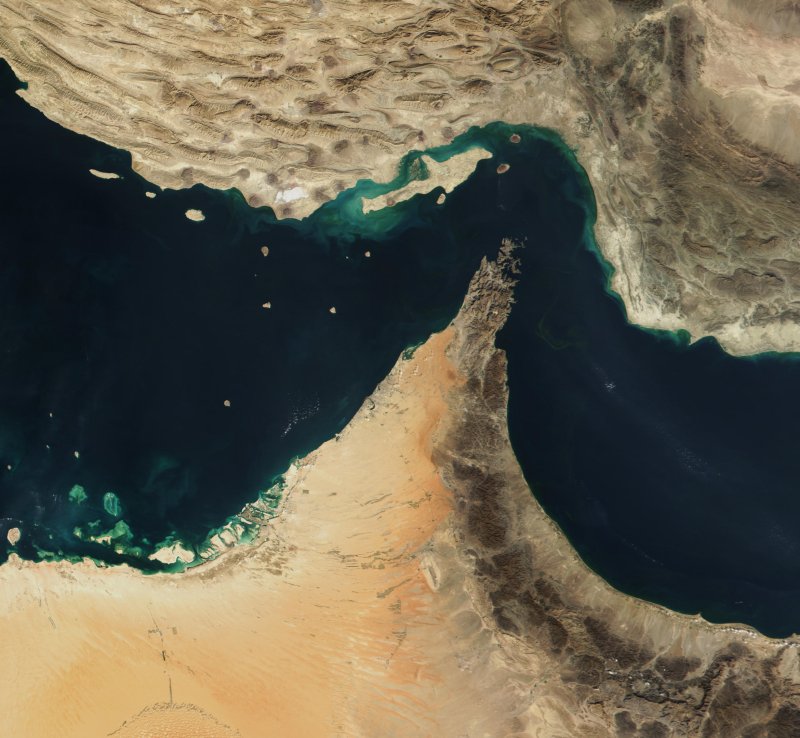The Strait of Hormuz is a vital waterway connecting the Persian Gulf and the Gulf of Oman, serving as the sole sea passage from the Persian Gulf to the open ocean. This makes it one of the world's most strategically important choke points for oil transport. Bordered by Iran to the north and the Musandam Peninsula (shared by the UAE and Oman) to the south, the strait is approximately 90 nautical miles long. Its width ranges from about 52 nautical miles to 21 nautical miles. Due to its geographical location, it is an important area geopolitically and economically.
14 hours ago : Tensions Rise: Oil Prices Surge as Israel Attacks Iran Near Hormuz Strait
Following reported Israeli attacks on Iran, global oil prices have soared. Tanker owners are wary of the Strait of Hormuz. Despite escalating tensions, experts believe Iran is unlikely to block the vital oil passage.
1958: Mention of the 1958 Convention on the High Seas
In May 2012, an article referenced the 1958 Convention on the High Seas, noting that blocking passage of vessels would violate this convention.
April 1959: Iran alters Strait legal status
In April 1959, Iran altered the legal status of the Strait of Hormuz by expanding its territorial sea to 12 nautical miles and declaring it would only recognize innocent passage through the expanded area.
1981: Oman issues royal decree
In 1981, Oman issued a royal decree that only innocent passage is permitted through its territorial sea.
December 1982: Iran signs UNCLOS with a declaration
In December 1982, upon signing the UNCLOS, Iran entered a declaration stating "that only states parties to the Law of the Sea Convention shall be entitled to benefit from the contractual rights created therein", including "the right of transit passage through straits used for international navigation".
1984: Start of Tanker War
In early 1984, the Tanker War phase of the Iran–Iraq War started when Iraq attacked the oil terminal and oil tankers at Iran's Kharg Island. Saddam Hussein aimed to provoke Iran into closing the Strait of Hormuz, which would invite American intervention. Iran limited retaliatory attacks to Iraqi shipping, leaving the strait open.
April 1988: Operation Praying Mantis
On April 18, 1988, the United States Armed Forces launched Operation Praying Mantis within Iranian territorial waters in retaliation for the Iranian naval mining of international waters in the Persian Gulf during the Iran–Iraq War and the subsequent damage to an American warship. The U.S. Navy attacked with surface warships and aircraft from the USS Enterprise and USS Truxtun.
July 1988: Iran Air Airbus A300 shot down
On July 3, 1988, 290 people were killed when an Iran Air Airbus A300 was shot down over the strait by the United States Navy guided missile cruiser USS Vincennes (CG-49) after it was wrongly identified as a jet fighter.
August 1989: Oman ratifies UNCLOS and submits declarations
Upon ratifying UNCLOS in August 1989, Oman submitted declarations confirming its 1981 royal decree that only innocent passage is permitted through its territorial sea and that prior permission was required before foreign warships could pass through Omani territorial waters.
May 1993: Iran enacts law on maritime areas
In May 1993, Iran enacted a comprehensive law on maritime areas. Several provisions of this law conflict with UNCLOS provisions, including a requirement that warships, submarines, and nuclear-powered ships obtain permission before exercising innocent passage through Iran's territorial waters.
2001: Iraq Pipeline Confiscated
In June 2012, it was noted that the Iraq Pipeline through Saudi Arabia (IPSA) had been confiscated from Iraq in 2001.
2002: Millennium Challenge 2002 War Game Simulates Strait Closure
In 2002, the United States armed forces conducted Millennium Challenge 2002, a major war game exercise. It simulated Iran's attempt to close the Strait of Hormuz. The assumptions and results of the exercise were controversial.
January 2007: USS Newport News strikes tanker
On January 8, 2007, the nuclear submarine USS Newport News, while traveling submerged, struck MV Mogamigawa, a 300,000-ton Japanese-flagged very large crude tanker, south of the strait. There were no injuries, and no oil leaked from the tanker.
December 2007: Naval stand-offs between Iran and US
In December 2007, a series of naval stand-offs between Iranian speedboats and U.S. warships occurred in the Strait of Hormuz. U.S. officials accused Iran of harassing and provoking their naval vessels, but Iranian officials denied the allegations.
2007: Report on oil flow through the Strait
A 2007 report from the Center for Strategic and International Studies stated that 17 million barrels passed out of the Persian Gulf daily, with oil flows through the Strait accounting for roughly 40% of all world-traded oil.
January 2008: US Navy contradicts Pentagon on Iran boat incident
In January 2008, a series of naval stand-offs between Iranian speedboats and U.S. warships occurred in the Strait of Hormuz. On 14 January 2008, U.S. Navy officials appeared to contradict the Pentagon version of the 16 January event, in which the Pentagon had reported that U.S. vessels had almost fired on approaching Iranian boats. The Navy's regional commander said the Iranians had "neither anti-ship missiles nor torpedoes" and he "wouldn't characterize the posture of the US 5th Fleet as afraid of these small boats".
June 2008: Iran threatens to seal off Strait of Hormuz
On June 29, 2008, the commander of Iran's Revolutionary Guard, Mohammad Ali Jafari, said that if either Israel or the United States attacked Iran, it would seal off the Strait of Hormuz to wreak havoc in the oil markets.
July 2008: Operation Brimstone joint exercises
In the last week of July 2008, during Operation Brimstone, dozens of U.S. and foreign naval ships underwent joint exercises for possible military activity in the shallow waters off the coast of Iran.
August 2008: Increased US naval presence
As of August 11, 2008, more than 40 U.S. and allied ships were reportedly en route to the Strait of Hormuz. One U.S. carrier battle group from Japan would complement the two already in the Persian Gulf, for a total of five battle groups, not including the submarines.
2008: Article Contends Iran Could Impede Strait Traffic
In 2008, an article in International Security suggested that Iran could potentially seal off or impede traffic in the Strait of Hormuz for a month, with a U.S. attempt to reopen it likely to escalate the conflict.
March 2009: USS Hartford and USS New Orleans collision
On March 20, 2009, the United States Navy Los Angeles-class submarine USS Hartford collided with the San Antonio-class amphibious transport dock USS New Orleans in the strait. The collision injured 15 sailors aboard Hartford and ruptured a fuel tank aboard New Orleans, spilling 25,000 US gallons of marine diesel fuel.
December 2011: US Responds to Iranian Naval Exercises
In December 2011, Captain John Kirby, a Pentagon spokesman, stated that efforts to increase tension near the Strait of Hormuz are unhelpful and counterproductive and that the US has sufficient capabilities in the region. Suzanne Maloney of the Brookings Institution commented that the U.S. military could address any Iranian threat relatively quickly.
December 2011: Iran Navy Conducts Exercise Near Strait of Hormuz
In December 2011, the Islamic Republic of Iran Navy commenced a ten-day exercise in international waters near the Strait of Hormuz. Rear Admiral Habibollah Sayyari stated that while Iranian forces could easily close the strait, such a decision would require political authorization.
December 2011: Iran threatens to cut off oil supply
On December 27, 2011, Iranian Vice President Mohammad Reza Rahimi threatened to cut off oil supply from the Strait of Hormuz should economic sanctions limit, or cut off, Iranian oil exports. The U.S. Fifth Fleet responded that it was "always ready to counter malevolent actions".
2011: Oil tanker traffic in 2011
According to the U.S. Energy Information Administration, in 2011, an average of 14 tankers per day passed out of the Persian Gulf through the Strait carrying 17 million barrels of crude oil, representing 35% of the world's seaborne oil shipments and 20% of oil traded worldwide. Most of the crude oil exports went to Asian markets, with Japan, India, South Korea, and China as the largest destinations.
January 2012: General Dempsey on Iran's Capabilities to Block the Strait
In January 2012, General Martin Dempsey, Chairman of the Joint Chiefs of Staff, acknowledged that Iran possesses capabilities to potentially block the Strait of Hormuz for a period. He also stated that the U.S. has invested in capabilities to ensure that they can defeat that.
January 2012: Crude futures rise after Iranian comments
In January 2012, Iranian comments regarding the Strait of Hormuz, coupled with new sanctions, drove crude futures higher, up over 4%. Pressure on prices reflected a combination of uncertainty driven further by China's response – reducing oil January 2012 purchases from Iran by 50% compared to those made in 2011.
January 2012: US sends letter to Iran regarding Strait of Hormuz
On January 16, 2012, the Iranian Foreign Ministry confirmed that it had received a letter from the United States concerning the Strait of Hormuz, "via three different channels." The United States had previously announced its intention to warn Iran that closing the Strait of Hormuz is a "red line" that would provoke an American response.
January 2012: Iran threatens action if US Navy returns carrier
On January 3, 2012, Iran threatened to take action if the U.S. Navy moves an aircraft carrier back into the Persian Gulf. Iranian Army chief Ataollah Salehi said the United States had moved an aircraft carrier out of the Persian Gulf because of Iran's naval exercises, and Iran would take action if the ship returned.
January 2012: Iran denies threat to close Strait of Hormuz
On January 9, 2012, Iranian Defense Minister Ahmad Vahidi denied that Iran had ever claimed that it would close the Strait of Hormuz, saying that "the Islamic Republic of Iran is the most important provider of security in the strait... if one threatens the security of the Persian Gulf, then all are threatened."
May 2012: Article on Legality of Blocking the Strait
In May 2012, an article by Nilufer Oral, a Turkish researcher of maritime law, concluded that blocking passage of vessels such as oil tankers by Iran would violate UNCLOS and the 1958 Convention on the High Seas.
June 2012: Saudi Arabia Reopens Iraq Pipeline
In June 2012, Saudi Arabia reopened the Iraq Pipeline through Saudi Arabia (IPSA), which was confiscated from Iraq in 2001. The pipeline travels from Iraq across Saudi Arabia to a Red Sea port and has a capacity of 1.65 million barrels per day.
July 2012: UAE Begins Using Habshan-Fujairah Oil Pipeline
In July 2012, the UAE started utilizing the new Habshan–Fujairah oil pipeline from the Habshan fields in Abu Dhabi to the Fujairah oil terminal on the Gulf of Oman, effectively bypassing the Strait of Hormuz. It has a maximum capacity of around 2 million barrels per day.
July 2012: Foreign Policy Article Compares Iran and Strait of Hormuz to Ottoman Empire and Dardanelles
In a July 2012 Foreign Policy article, Gal Luft compared Iran and the Strait of Hormuz to the Ottoman Empire and the Dardanelles, noting that tensions are leading countries dependent on shipments from the Persian Gulf to seek alternatives.
2012: Christian Science Monitor Article Discusses Millennium Challenge 2002 Results
In 2012, an article in The Christian Science Monitor discussed the Millennium Challenge 2002 war game. The article suggested that Iran's strategy had beaten the materially superior U.S. armed forces during the simulation.
2013: Status of Treaty Ratifications
As of 2013, a treaty had been ratified by 63 states, including most NATO-bloc and Soviet-bloc nations but with the notable exceptions of most of the OPEC and Arab League nations like Syria, Egypt, Jordan, Saudi Arabia, and Iran, as well as China, North Korea, and South Korea.
April 2015: Maersk Tigris incident
On April 28, 2015, IRGCN patrol boats contacted the Marshall Islands-flagged container ship Maersk Tigris, which was westbound through the strait, and directed the ship to proceed further into Iranian territorial waters. When the ship's master declined, one of the Iranian craft fired shots across the bridge of Maersk Tigris. The captain complied and proceeded into Iranian waters near Larak Island. The US Navy sent aircraft and a destroyer, USS Farragut, to monitor the situation.
July 2018: Iran threatens to close the Strait
In July 2018, Iran again made threats to close the Strait of Hormuz, citing looming American sanctions after the U.S. withdrew from the JCPOA deal earlier in the year. Iran's Revolutionary Guards reported they were ready to carry out the action if required.
August 2018: Iran test-fires ballistic missile
In August 2018, Iran test-fired a ballistic missile, the anti-ship Fateh-110 Mod 3, for the first time in 2018. The missile flew over 100 miles on a flight path over the Strait of Hormuz to a test range in the Iranian desert.
2018: Oil flow in 2018
In 2018, 21 million barrels a day were passing through the strait, which means $1.17 billion worth of oil a day, at September 2019 prices.
April 2019: US ends oil waivers to Iran's customers
On April 22, 2019, the U.S. ended the oil waivers, which allowed some of Iran's customers to import Iranian oil without risking financial penalties as part of the U.S. economic sanctions against Iran. This led to Iranian threats of Strait closure.
June 2019: Attacks on oil tankers
On the morning of June 13, 2019, the oil tankers Front Altair and Kokuka Courageous were both rocked by explosions shortly before dawn. The crew of the Kokuka Courageous reported seeing a flying object strike the ship. The crew were rescued by the destroyer USS Bainbridge while the crew of the Front Altair were rescued by Iranian ships. The U.S. accused Iran of the attacks, but Iran denied the accusations, calling the incident a false-flag attack.
July 2019: Seizure of Stena Impero
In July 2019, a Stena Bulk Tanker, Stena Impero, sailing under a British flag, was boarded and captured by Iranian forces. The spokesman for Iran's Guardian Council described the seizure as a "reciprocal action", presumed to be in reference to the seizure of an Iranian tanker, Grace 1, bound for Syria in Gibraltar a few days prior.
September 2019: Oil prices through the strait
In 2018, 21 million barrels a day were passing through the strait, which means $1.17 billion worth of oil a day in September 2019 prices.
April 2020: France Deploys Troops Under CTF474 to Protect Maritime Trade
In April 2020, France deployed approximately 600 troops by sea and air under the CTF474 to safeguard maritime trade and regional business and decrease local tensions. As of the first week of April 2020, the operation included the Dutch frigate Ruyter, the French frigate Forbin, and a French ATLANTIC2 airplane (ATL2).
May 2020: Iran Launches Missiles at Own Ship
In May 2020, Iran accidentally launched missiles at one of its own ships in a friendly fire incident, resulting in the death of 19 sailors.
January 2021: South Korea-Flagged Oil Vessel Seized for Alleged Pollution
On January 4, 2021, the Tasnim News Agency reported that a South Korea-flagged oil vessel, Hankuk Chemi, en route from Saudi Arabia to the United Arab Emirates, was seized for allegedly violating pollution regulations. The ship was reportedly carrying approximately 7,000 tons of ethanol.
June 2021: IRIS Kharg Sinks in Strait of Hormuz
On June 2, 2021, the IRIS Kharg, a modified Ol-class replenishment oiler belonging to the Islamic Republic of Iran Navy, sank in the Strait of Hormuz after a fire. It was the IRIN's largest vessel.
April 2024: Iranian IRGC Navy Seizes MSC Aries
On April 13, 2024, the Iranian IRGC Navy seized MSC Aries, a Portuguese-flagged container ship sailing through the Gulf of Oman off the coast of the UAE port city of Fujairah. The ship was steered through the strait with 25 personnel on board, under the claim of maritime law violations. The MSC Aries is leased by MSC from Gortal Shipping, an affiliate of Zodiac Maritime.
Mentioned in this timeline
The United States of America is a federal republic located...
Saudi Arabia officially the Kingdom of Saudi Arabia KSA is...

A submarine is a watercraft capable of independent operation underwater...
India officially the Republic of India is a South Asian...
Japan is an East Asian island country in the Pacific...
China officially the People's Republic of China PRC is an...
Trending

43 minutes ago Ozzy Osbourne & Black Sabbath Celebrated with Museum & Exhibitions in Birmingham, UK.

44 minutes ago Wyndham Clark Faces Accusations After US Open; Rory McIlroy Struggles at Oakmont

44 minutes ago George Strait Concert in Buffalo: Traffic, Parking, and Set Times Information

5 days ago Jackson Merrill MLB Prop Bets and Luis Arraez Player Performance Insights
2 hours ago Bobrovsky's Calmness Boosts Panthers in Stanley Cup Final Amidst Oilers' Challenge.
1 day ago Bryce Perkins Seeks Fun, Super Bowl Experience Fuels UFL Championship Bid
Popular

The Boeing Dreamliner is an American wide-body airliner developed by...

Greta Thunberg is a Swedish climate activist who gained international...

Cristiano Ronaldo often called CR is a Portuguese professional footballer...

Thomas Douglas Homan is an American law enforcement officer and...

Gavin Newsom is an American politician and businessman currently serving...

Playboi Carti born Jordan Terrell Carter is an American rapper...
